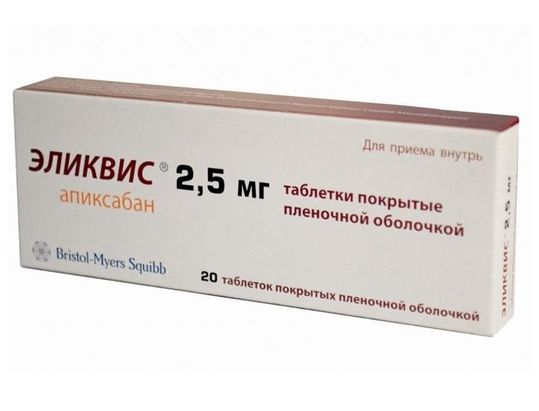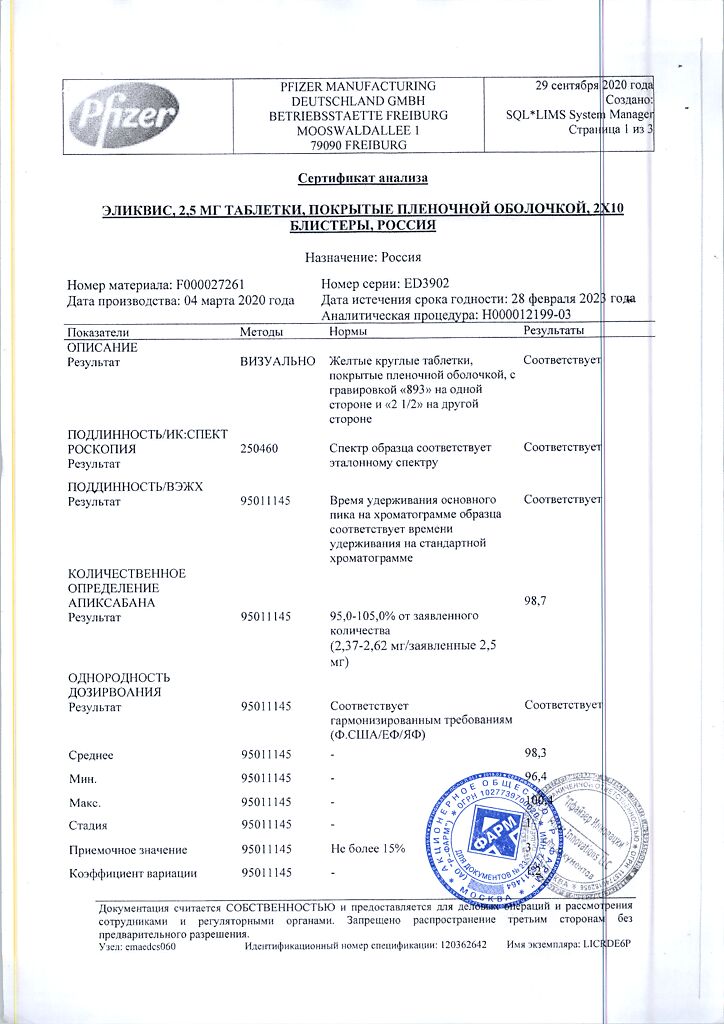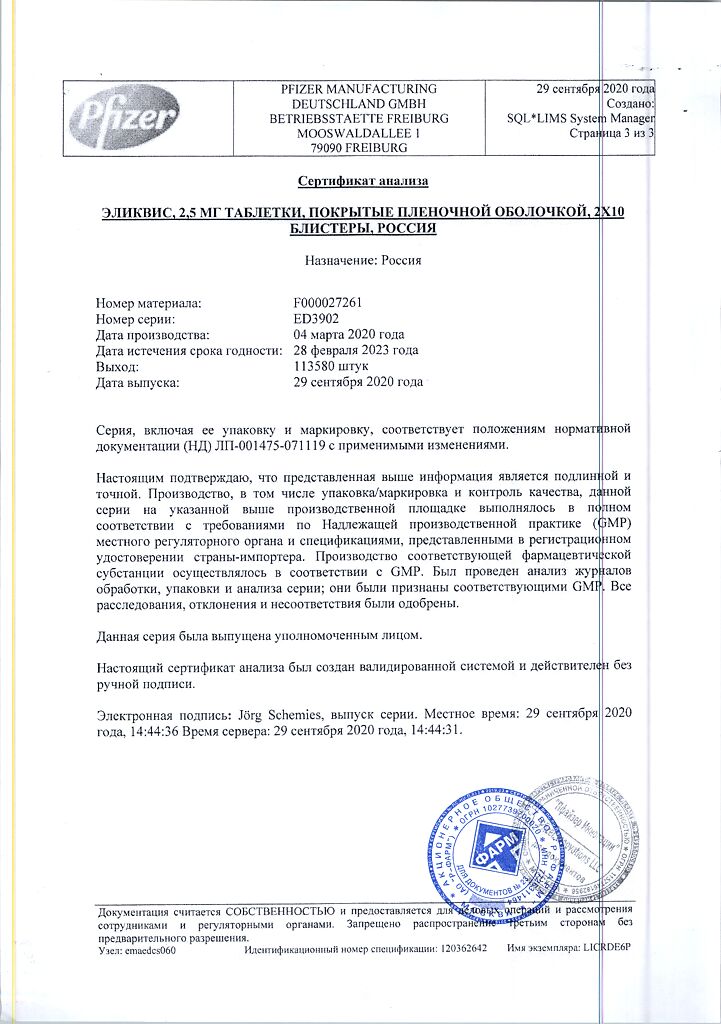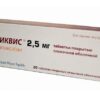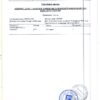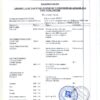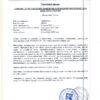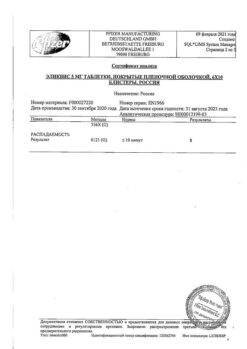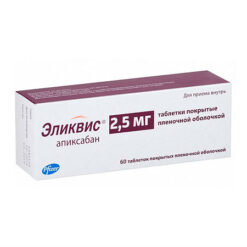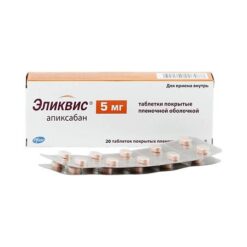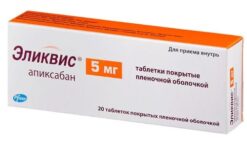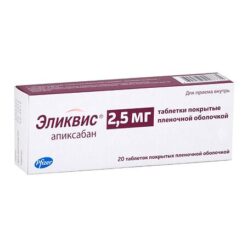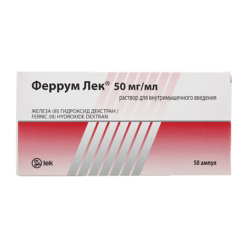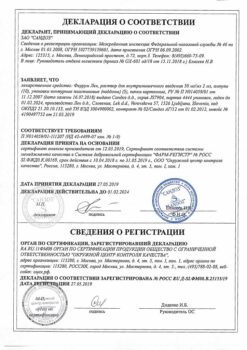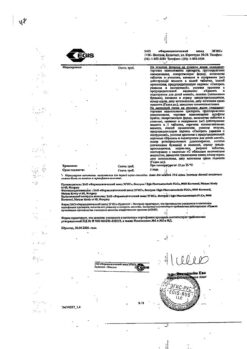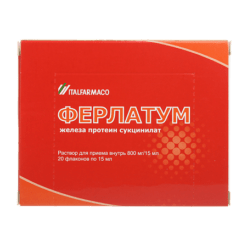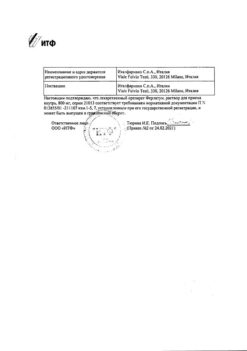No products in the cart.
Eliquis, 2.5mg 20 pcs.
€23.95 €20.75
Description
Eliquis has antithrombotic effect.
Pharmacodynamics
The mechanism of action of apixaban is inhibition of FXa activity. As a result apixaban changes values of parameters of blood coagulation system:
prolongs prothrombin time, MHO and activated partial thromboplastin time (APTB). Changes in these parameters when using the drug in a therapeutic dose are insignificant and individual. Therefore, their use to assess the pharmacodynamic activity of apixaban is not recommended. Inhibition of FXa activity by apixaban has been proved by chromogenic test using heparin “Rotachrom.
Change in anti-FXa activity is directly proportional to increase in plasma concentration of apixaban, and maximum values of activity are observed when maximum, plasma concentration of apixaban is reached. A linear relationship between the concentration and anti-FXa activity of apixaban is registered in a wide range of therapeutic doses of the drug!
Changes in anti-FXa activity with changes in dose and concentration, apixaban is more pronounced and less variable than blood clotting parameters. The expected maximum and minimum anti-FXa activity of apixaban at equilibrium, when administered at a dose of 2.5 mg-2 times daily, is 1.3 IU/mL (5/95 percentile – 0.67 IU/mL – 2,4 IU/ml) and 0.84 IU/ml (5/95 percentile -0.37 IU/ml – 1.8 IU/ml), respectively, which correlates with fluctuations in this index between doses of the drug (less than 1.6 times). Against the background of apixaban therapy, routine monitoring of its plasma concentrations is not required, but performance of anti-FXa Rotachrom activity test may be useful for making a decision on continuation of therapy.
Mechanism of action
Apixaban is a potent direct FXa inhibitor that reversibly and selectively blocks the active center of the enzyme, intended for oral use. Antithrombin III is not required for realization of the antithrombotic effect of apixaban. Apixaban inhibits free and bound FXa as well as prothrombinase activity. Apixaban has no direct direct effect on platelet aggregation, but indirectly inhibits platelet aggregation induced by thrombin. By inhibiting the activity of FXa apixaban prevents thrombin and thrombus formation.
Pharmacokinetics
Absorption
Absolute bioavailability of apixaban reaches 50% when used in doses up to 10 mg. Apixaban is rapidly absorbed from the gastrointestinal tract, its maximum concentration (Cmax) is reached within 3-4 hours after oral administration. Food intake has no effect on the values of area under the curve “concentration-time” (AUC) or Cmax apixaban. Apixaban pharmacokinetics for doses up to 10 mg is linear. When apixaban is administered in doses above 25 mg, limited absorption of the drug is noted, which is accompanied by a decrease in its bioavailability. Metabolic parameters of apixaban are characterized by low to moderate inter- and intraindividual variability (the respective coefficient of variation values are ∼20% and ∼30%, respectively).
Distribution
The binding of apixaban to human plasma proteins is approximately 87%, the volume of distribution (V85) is approximately 21L.
Metabolism and excretion
Approximately 25% of the dose taken is excreted as metabolites, most of it – through the intestine. Renal excretion of apixaban is about 27% of its total clearance.
The total clearance of apixaban is approximately 3.3 l/hour, the half-life (T1/2) is about 12 hours. O-demethylation and hydroxylation by 3-oxopiperidinyl residue are the main pathways of apixaban biotransformation. Apixaban is predominantly metabolized with participation of CYP3A4/5 isoenzyme, to a lesser extent – CYP1A2, 2C8, 2C9, 2C19 and 2J2 isoenzymes. Unchanged apixaban is the main substance circulating in human blood plasma, there are no active metabolites circulating in bloodstream. In addition, apixaban is a substrate of transport proteins, P-glycoprotein 70 and breast cancer resistance protein (BCRP).
Renal dysfunction
Renal dysfunction has no effect on the maximum concentration of apixaban. However, there was an increase in apixaban concentration that correlated with the degree of decrease in renal function as assessed by creatinine clearance values. In patients with mild (creatinine clearance – 51 ml/min to 80 ml/min), moderate (creatinine clearance – 30 ml/min to 50 ml/min) and severe (creatinine clearance – 15 ml/min to 29 ml/min) renal function disorders the AUC values of apixaban in plasma increased by 16%, 29% and 44%, respectively, compared to those patients who had normal creatinine clearance values. Moreover, impaired renal function had no apparent effect on the relationship between plasma concentrations of apixaban and its anti-FXa activity.No studies of apixaban in patients with creatinine clearance <15 ml/min or those on dialysis have been conducted.
Hepatic impairment
Studies of apixaban in severe hepatic impairment and active hepatobiliary pathology have not been performed.
In a study of pharmacokinetics and pharmacodynamics of apixaban at a single dose of 5 mg in patients with mild to moderate hepatic impairment (Child-Pugh grades A and B, respectively) and healthy volunteers it was shown that hepatic impairment has no effect on these parameters. Changes in anti-FXa activity and MHO in patients with moderate hepatic insufficiency and healthy volunteers were comparable.
Use in elderly patients
In elderly patients (over 65 years old) higher values of drug concentration in plasma were observed than in younger patients: the average AUC was approximately 32% higher. No adjustment of the drug dose in elderly patients is required.
Position
Apixaban exposure in women was 18% higher than in men.
No adjustment of the drug dose according to the patient’s gender is required.
Race and ethnicity
The results obtained in Phase I studies indicate that there are no significant differences in apixaban pharmacokinetics between Caucasoid, Mongoloid and Negroid races. The results of pharmacokinetic analyses in different populations performed in studies including patients receiving apixaban after elective hip or knee arthroplasty are consistent with the results of the phase studies. No dose adjustments are required based on the race or ethnicity of the patient.
Body weight
Patients with body weight greater than 120 kg had plasma apixaban concentrations approximately 30% lower than those of patients with body weight between 65 kg and 85 kg; patients with body weight less than 50 kg had approximately 30% higher concentrations. No dose adjustment is required depending on the patient’s body weight.
Dependence of pharmacokinetic and pharmacodynamic parameters
The relationship between pharmacokinetic and pharmacodynamic parameters (including anti-FXa activity, MHO, prothrombin time, ACTV) of apixaban and its plasma concentration has been studied for a wide range of drug doses (from 0.5 mg to 50 mg). It was shown that the relationship between apixaban concentration and FXa activity is best described using a linear model. The dependence of pharmacokinetic and pharmacodynamic parameters of apixaban evaluated in patients undergoing elective hip or knee arthroplasty was consistent with that observed in healthy volunteers.
Indications
Indications
Prevention of venous thromboembolism in patients after planned hip or knee replacement.
Pharmacological effect
Pharmacological effect
Eliquis has an antithrombotic effect.
Pharmacodynamics
The mechanism of action of apixaban is the inhibition of FXa activity. As a result, apixaban changes the values of the blood coagulation system:
prolongs prothrombin time, MHO and activated partial thromboplastin time (APTT). Changes in these indicators when using the drug in a therapeutic dose are insignificant and individual. Therefore, their use to assess the pharmacodynamic activity of apixaban is not recommended. The inhibition of FXa activity by apixaban was proven using a chromogenic test using heparin “Rotachrom.
The change in anti-FXa activity is directly proportional to the increase in the concentration of apixaban in the plasma and blood, with maximum activity values observed when the maximum concentration of apixaban in the blood plasma is reached. A linear relationship between the concentration and anti-FXa activity of apixaban is recorded over a wide range of therapeutic doses of the drug!
Changes in anti-FXa activity with changes in dose and concentration of apixaban are more pronounced and less variable than blood coagulation parameters. The expected maximum and minimum anti-FXa activity of apixaban at steady state, when used at a dose of 2.5 mg 2 times a day, is 1.3 IU/ml (5/95th percentile – 0.67 IU/ml – 2.4 IU/ml) and 0.84 IU/ml (5/95th percentile -0.37 IU/ml- 1.8 IU/ml), respectively, which correlates with fluctuations in this indicator in the interval between taking doses of the drug (less than 1.6 times). Routine monitoring of apixaban plasma concentrations is not required during apixaban therapy, but the Rotachrom anti-FXa activity test may be useful in deciding whether to continue therapy.
Mechanism of action
Apixaban is a potent, direct FXa inhibitor that reversibly and selectively blocks the enzyme’s active site for oral administration. The antithrombotic effect of apixaban does not require the presence of antithrombin III. Apixaban inhibits free and bound FXa, as well as prothrombinase activity. Apixaban has no immediate direct effect on platelet aggregation, but indirectly inhibits thrombin-induced platelet aggregation. By inhibiting FXa activity, apixaban prevents the formation of thrombin and blood clots.
Pharmacokinetics
Suction
The absolute bioavailability of apixaban reaches 50% when used in doses of up to 10 mg. Apixaban is rapidly absorbed from the gastrointestinal tract, its maximum concentration (Cmax) is reached within 3-4 hours after oral administration. Food intake does not affect the area under the concentration-time curve (AUC) or Cmax of apixaban. The pharmacokinetics of apixaban for doses up to 10 mg is linear. When taking apixaban in doses above 25 mg, limited absorption of the drug is observed, which is accompanied by a decrease in its bioavailability. Metabolism parameters of apixaban are characterized by low to moderate inter- and intra-individual variability (the corresponding coefficient of variation values are ∼20% and ∼30%, respectively).
Distribution
The binding of apixaban to human plasma proteins is approximately 87%, the volume of distribution (V85) is approximately 21 L.
Metabolism and excretion
Approximately 25% of the dose taken is excreted as metabolites, most of it through the intestines. Renal excretion of apixaban accounts for approximately 27% of its total clearance.
The total clearance of apixaban is approximately 3.3 l/hour, the half-life (T1/2) is about 12 hours. O-demethylation and hydroxylation at the 3-oxopiperidinyl residue are the main biotransformation pathways of apixaban. Apixaban is predominantly metabolized by the CYP3A4/5 isoenzyme, and to a lesser extent by the CYP1A2, 2C8, 2C9, 2C19 and 2J2 isoenzymes. Unchanged apixaban is the main substance circulating in human plasma; there are no active metabolites circulating in the bloodstream. In addition, apixaban is a substrate of the transport proteins P-glycoprotein 70 and breast cancer resistance protein (BCRP).
Renal dysfunction
Impaired renal function does not affect the maximum concentration of apixaban. However, there was an increase in apixaban concentrations, which correlated with the degree of decrease in renal function, assessed by creatinine clearance values. In individuals with mild renal impairment (creatinine clearance – from 51 ml/min to 80 ml/min), moderate (creatinine clearance – from 30 ml/min to 50 ml/min) and severe (creatinine clearance – from 15 ml/min to 29 ml/min), the AUC values of apixaban in blood plasma increased by 16%, 29% and 44%, respectively, compared with individuals who had normal creatinine clearance values. However, renal impairment did not have an obvious effect on the relationship between the concentration of apixaban in the blood plasma and its anti-FXa activity. Studies of apixaban in patients with creatinine clearance <15 ml/min or on dialysis have not been conducted.
Liver dysfunction
Apixaban has not been studied in severe liver failure and active hepatobiliary pathology.
In a study of the pharmacokinetics and pharmacodynamics of apixaban at a single dose of 5 mg in patients with mild to moderate hepatic impairment (Child-Pugh classes A and B, respectively) and healthy volunteers, it was shown that liver failure does not affect these indicators. Changes in anti-FXa activity and MHO in patients with moderate hepatic impairment and healthy volunteers were comparable.
Use in elderly patients
Elderly patients (over 65 years of age) had higher plasma concentrations of the drug than younger patients: the mean AUC was approximately 32% higher. No dose adjustment is required in elderly patients.
Gender
Exposure to apixaban was 18% higher in women than in men.
No dose adjustment is required depending on the gender of the patient.
Race and Ethnicity
The results obtained in phase I studies indicate that there are no significant differences in the pharmacokinetics of apixaban between representatives of the Caucasian, Mongoloid and Negroid races. Results from cross-population pharmacokinetic analyzes performed in studies that included patients receiving apixaban after elective hip or knee replacement were consistent with the results of the phase studies. No dosage adjustment is required depending on the race or ethnic origin of the patient.
Body weight
In patients weighing more than 120 kg, plasma apixaban concentrations were approximately 30% lower than in patients weighing 65 kg to 85 kg; in patients weighing less than 50 kg, this figure was approximately 30% higher. No dose adjustment is required depending on the patient’s body weight.
Dependence of pharmacokinetics and pharmacodynamics parameters
The relationship between pharmacokinetics and pharmacodynamics parameters (including anti-FXa activity, MHO, prothrombin time, aPTT) of apixaban and its plasma concentrations was studied for a wide range of drug doses (from 0.5 mg to 50 mg). The relationship between apixaban concentration and FXa activity has been shown to be best described using a linear model. The relationship between the pharmacokinetics and pharmacodynamics of apixaban, assessed in patients undergoing elective hip or knee replacement, was consistent with that observed in healthy volunteers.
Special instructions
Special instructions
In patients with atrial fibrillation and conditions requiring the use of monotherapy or combination therapy of two antiplatelet drugs, a careful assessment of the benefit/risk ratio should be carried out before concomitant use with Eliquis. Eliquis is not recommended for use in patients with liver disease associated with coagulation disorders and a clinically significant risk of bleeding.
It was shown that in high-risk patients following acute coronary syndrome, with multiple cardiac and non-cardiac comorbidities, there was a significant increase in the risk of bleeding when co-administered apixaban and acetylsalicylic acid or a combination of acetylsalicylic acid and clopidogrel compared with placebo.
As with other anticoagulants, patients taking Eliquis should be closely monitored for bleeding. If severe bleeding develops, Eliquis should be discontinued. If hemorrhagic complications develop, it is necessary to discontinue treatment with the drug and perform an examination to identify the source of bleeding. If necessary, appropriate treatment is prescribed, in particular surgical control of bleeding or transfusion of fresh frozen blood plasma.
Cancellation of anticoagulant therapy, incl. apixaban, with active bleeding before elective surgery or an invasive procedure, may lead to an increased risk of thrombosis. Prolonged discontinuation of therapy should be avoided and if apixaban therapy must be temporarily discontinued, it should be restarted as soon as possible.
Performing spinal, epidural, or puncture in patients receiving Eliquis
When performing spinal or epidural anesthesia or diagnostic puncture of these areas in patients receiving antithrombotic drugs to prevent thromboembolism, there is a risk of developing epidural or spinal hematomas, which, in turn, can cause persistent or irreversible paralysis. This risk may further increase when using an installed epidural catheter in the postoperative period or when using other drugs that affect hemostasis in parallel. Established epidural or subarachnoid catheters should be removed at least 5 hours before the first dose of Eliquis. A similar increase in risk may be observed when performing traumatic or repeated punctures of the epidural or subarachnoid spaces. Frequent monitoring of patients is necessary for the development of manifestations of nervous system dysfunction (in particular, numbness or weakness of the lower extremities, impaired bowel or bladder function).
If such disorders develop, emergency examination and treatment are necessary. Before performing interventions on the epidural or subarachnoid spaces in patients receiving anticoagulants, incl. In order to prevent thrombosis, an assessment of the ratio of potential benefits and risks is necessary.
Impact on the ability to drive vehicles and operate other machinery. Eliquis does not have a significant effect on the ability to drive a car or operate machinery.
Active ingredient
Active ingredient
Apixaban
Composition
Composition
1 film-coated tablet contains:
active ingredient:
apixaban 2.5 mg.
excipients:
lactose,
microcrystalline cellulose,
croscarmellose sodium,
sodium lauryl sulfate,
magnesium stearate;
film coating Opadry II Yellow (hypromellose 15 cps, lactose monohydrate, titanium dioxide, triacetin, iron oxide yellow dye).
Pregnancy
Pregnancy
There is only limited information on the use of Eliquis during pregnancy. The use of apixaban during pregnancy is not recommended.
There is no information on the excretion of apixaban or its metabolites into breast milk in humans. If it is necessary to use the drug Eliquis during lactation, breastfeeding should be discontinued.
Contraindications
Contraindications
hypersensitivity to any component of Eliquis;
clinically significant bleeding;
severe liver dysfunction;
impaired renal function with Cl creatinine less than 15 ml/min, as well as use in patients on dialysis;
pregnancy;
breast-feeding;
age up to 18 years.
It is not recommended to use apixaban simultaneously with drugs that may be associated with the development of serious bleeding.
With caution: apixaban should be used with caution in patients with moderate to mild hepatic impairment (Child-Pugh class A or B); performing spinal/epidural anesthesia or spinal/epidural puncture; in patients receiving systemic therapy with potent inhibitors of the CYP3A4 isoenzyme and P-glycoprotein, such as azole antifungals (in particular ketoconazole, itraconazole, voriconazole and posaconazole), HIV protease inhibitors (for example, ritonavir); when using apixaban with powerful inducers of the CYP3A4 isoenzyme and P-glycoprotein (in particular, rifampicin, phenytoin, carbamazepine, phenobarbital or St. John’s wort preparations).
Side Effects
Side Effects
The frequency of adverse reactions is understood as: often – ≥1/100, <1/10; uncommon - ≥1/1000, <1/100; rarely - ≥1/10000, <1/1000.
Prevention of venous thromboembolism in patients after elective hip or knee replacement
Adverse reactions were reported in 11% of patients receiving apixaban 2.5 mg twice daily. As with other anticoagulants, bleeding may occur in patients with risk factors, such as organic lesions, which may be accompanied by bleeding. The most common side effects were anemia, bleeding, hematomas, and nausea. Adverse reactions that developed in patients undergoing orthopedic surgery during apixaban therapy are presented below.
From the blood and lymphatic system: often – anemia (including postoperative and post-hemorrhagic, accompanied by corresponding changes in laboratory test results), bleeding (including hematoma, vaginal and urethral bleeding); uncommon – thrombocytopenia (including decreased platelet count).
From the immune system: rarely – hypersensitivity.
From the organ of vision: rarely – hemorrhages in the tissue of the eyeball (including hemorrhage in the conjunctiva).
From the cardiovascular system: infrequently – arterial hypotension (including hypotension during the procedure).
From the respiratory system: infrequently – nosebleeds; rarely – hemoptysis.
From the gastrointestinal tract: often – nausea; uncommon – gastrointestinal bleeding (including vomiting mixed with blood and melena), the presence of unchanged blood in the stool; rarely – rectal bleeding, bleeding from the gums.
From the liver and biliary tract: infrequently – increased activity of transaminases, incl. increased activity of ALT, AST, GGTP, pathological changes in liver function tests, increased activity of alkaline phosphatase in the blood, increased concentration of bilirubin in the blood.
From the musculoskeletal system: rarely – muscle hemorrhage.
From the urinary system: infrequently – hematuria (including corresponding changes in laboratory test results).
Other: often – closed injury; uncommon – hemorrhage and bleeding after invasive procedures (including hematoma after the procedure, bleeding from a postoperative wound, hematoma in the area of vascular puncture and at the site of catheter installation), the presence of discharge from the wound, hemorrhage in the incision area (including hematoma in the incision area), bleeding during surgery.
Prevention of strokes and systemic embolism in patients with atrial fibrillation
From the immune system: uncommon – hypersensitivity (including drug hypersensitivity reactions such as skin rash and anaphylactic reactions, allergic edema).
From the nervous system: uncommon – intracranial hemorrhage, subarachnoid hemorrhage, subdural hematoma, hemorrhage into the spinal canal, spinal hematoma.
On the part of the organ of vision: often – hemorrhages in the tissue of the eyeball (including hemorrhage in the conjunctiva).
From the cardiovascular system: often – other types of bleeding, hematomas; infrequently – bleeding into the abdominal cavity.
From the respiratory system: often – nosebleeds; infrequently – hemoptysis; rarely – bleeding into the organs of the respiratory system (including pulmonary alveolar hemorrhage, laryngeal and pharyngeal bleeding).
From the gastrointestinal tract: often – gastrointestinal bleeding (including vomiting mixed with blood and melena), rectal bleeding, bleeding from the gums; uncommon – hemorrhoidal bleeding, the presence of unchanged blood in the stool, bleeding into the oral cavity; rarely – retroperitoneal hemorrhage.
From the urinary system: often – hematuria.
From the reproductive system: infrequently – intermenstrual vaginal bleeding, urogenital bleeding.
Reactions at the injection site: uncommon – bleeding at the injection site.
Laboratory indicators: infrequently – a positive reaction in a stool test for occult blood.
Other: often – closed injury; uncommon – traumatic bleeding, bleeding after the procedure, hemorrhage in the incision area.
Interaction
Interaction
Effect of other drugs on the pharmacokinetics of apixaban Inhibitors of the isoenzyme CYP3A4 and P-glycoprotein
The combination of apixaban with ketoconazole (at a dose of 400 mg, 1 time per day), which is a powerful inhibitor of both the CYP3A4 isoenzyme and P-glycoprotein, led to an increase in the average AUC value of apixaban by 2 times and the average Cmax value by 1.6 times. No dose adjustment of apixaban is required when combined with ketoconazole, but apixaban should be used with caution in patients receiving systemic therapy with azole antifungals, in particular ketoconazole, or other potent inhibitors of the CYP3A4 isoenzyme and P-glycoprotein.
Drugs that moderately reduce the elimination rate of apixaban or inhibit CYP3A4 and/or P-glycoprotein are expected to increase plasma concentrations of apixaban to a lesser extent. For example, diltiazem (a moderate inhibitor of the CYP3A4 isoenzyme and a weak inhibitor of P-glycoprotein) at a dose of 360 mg 1 time per day led to an increase in the mean AUC values of apixaban by 1.4 times and the mean Cmax values by 1.3 times. Naproxen (a P-glycoprotein inhibitor), when administered at a dose of 500 mg to healthy volunteers, increased the mean AUC and Cmax values of apixaban by 1.5 and 1.6 times, respectively. At the same time, there was an increase in the values of blood coagulation parameters. However, against the background of this combination, there was no effect of naproxen on platelet aggregation associated with impaired arachidonic acid metabolism and no clinically significant prolongation of bleeding time.
No dose adjustment of apixaban is required when combined with moderate inhibitors of the CYP3A4 isoenzyme and/or P-glycoprotein.
Inducers of the isoenzyme CYP3A4 and P-glycoprotein
The combination of apixaban with rifampicin (a potent inducer of CYP3A4 and P-glycoprotein) resulted in a decrease in the mean AUC and Cmax of apixaban by approximately 54% and 42%, respectively. Apparently, the combination of apixaban with other potent inducers of the CYP3A4 isoenzyme and P-glycoprotein (in particular, phenytoin, carbamazepine, phenobarbital or St. John’s wort preparations) may also lead to a decrease in the concentration of apixaban in the blood plasma. No dose adjustment of apixaban is required when combined with drugs in this group, but these drugs should be combined with caution.
Anticoagulants, platelet aggregation inhibitors and NSAIDs
After co-administration of enoxaparin (single dose, 40 mg) and apixaban (single dose, 5 mg), an additive effect of these drugs on FXa activity was noted.
There were no signs of pharmacokinetic or pharmacodynamic interaction of apixaban with acetylsalicylic acid (at a dose of 325 mg, 1 time per day) in healthy people.
The combination of apixaban with clopidogrel (at a dose of 75 mg, 1 time per day) or a combination of clopidogrel (75 mg) and acetylsalicylic acid (162 mg, 1 time per day) in phase I of the clinical trial did not lead to an increase in bleeding time, further inhibition of platelet aggregation or an increase in blood coagulation parameters (prothrombin time, MHO and APTT) compared with the use of these antiplatelet agents in monotherapy.
However, caution should be exercised when using apixaban simultaneously with NSAIDs (including acetylsalicylic acid), due to the fact that these drugs increase the risk of bleeding.
It is not recommended to concomitantly use drugs that may be associated with the development of serious bleeding, such as: unfractionated heparin or heparin derivatives (including low molecular weight heparins), oligosaccharides that inhibit FXa (for example, fondaparinux), direct thrombin II inhibitors (for example, desirudin), thrombolytic drugs, glycoprotein IIb/IIIa receptor antagonists, thienopyridines (for example, clopidogrel), dipyridamole, dextran, sulfinpyrazone, vitamin K antagonists and other oral anticoagulants. It should be noted that unfractionated heparin can be used in doses necessary to maintain the patency of a venous or arterial catheter.
Combination with other drugs
There were no clinically significant pharmacokinetic or pharmacodynamic interactions of apixaban with atenolol or famotidine. Combining apixaban (at a dose of 10 mg) with atenolol (at a dose of 100 mg) did not lead to the development of clinically significant changes in the pharmacokinetic parameters of apixaban, but it was accompanied by a decrease in the average AUC and Cmax values of apixaban by 15% and 18%, respectively, compared with the monotherapy regimen. Administration of apixaban (at a dose of 10 mg) with famotidine (at a dose of 40 mg) had no effect on the AUC or Cmax values of apixaban.
Effect of apixaban on the pharmacokinetics of other drugs
In in vitro studies, apixaban did not inhibit the activity of the isoenzymes CYP1A2, CYP2A6, CYP2B6, CYP2C8, CYP2C9, CYP2D6 or CYP3A4/ (inhibitory concentration (IC50) > 45 μmol/L), however, weak suppression of the activity of the CYP2C19 isoenzyme (IC50 > 20 μmol/L) was found with apixaban at a concentration significantly higher than the maximum concentration of the drug in blood plasma during its clinical use. Apixaban is not an inducer of the isoenzymes CYP1A2, CYP2B6, CYP3A4/5 at concentrations up to 20 µmol/l. In this regard, it is expected that when used together it will not affect the clearance of drugs metabolized by these isoenzymes. In addition, apixaban does not significantly inhibit P-gp activity.
In studies in healthy volunteers, apixaban did not significantly alter the pharmacokinetics of digoxin, naproxen, or atenolol.
Overdose
Overdose
Symptoms: the risk of bleeding increases. In controlled clinical studies, apixaban was administered orally to healthy volunteers in doses up to 50 mg/day for 3–7 days (25 mg, twice daily for 7 days or 50 mg, once daily for 3 days); There were no clinically significant undesirable effects.
Treatment: Activated carbon may be considered. The antidote for the drug is unknown.
Storage conditions
Storage conditions
At a temperature not exceeding 30 °C
Shelf life
Shelf life
3 years
Manufacturer
Manufacturer
Bristol-Myers Squibb Manufacturing Company, Puerto Rico
Additional information
| Shelf life | 3 years |
|---|---|
| Conditions of storage | At a temperature not exceeding 30 °C |
| Manufacturer | Bristol-Myers Squibb Manufacturing Company, Puerto Rico |
| Medication form | pills |
| Brand | Bristol-Myers Squibb Manufacturing Company |
Other forms…
Related products
Buy Eliquis, 2.5mg 20 pcs. with delivery to USA, UK, Europe and over 120 other countries.

